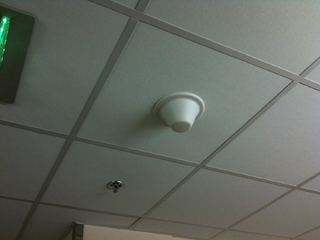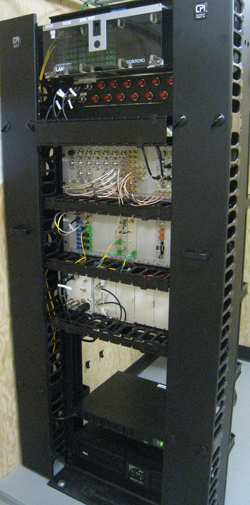|
Subscribe / Renew |
|
|
Contact Us |
|
| ► Subscribe to our Free Weekly Newsletter | |
| home | Welcome, sign in or click here to subscribe. | login |
Architecture & Engineering
| |
 |
October 25, 2012
How strong is your building’s public safety radio signal?
Sparling

Ruschak
|
Hurricane Katrina, the 9/11 attacks, and other tragic events in the past few decades sent emergency personnel into the depths of modern structures with their portable radios as their only lifeline to the outer world. In many cases, their attempts to relay critical information were futile due to the inability of radio signals to penetrate the structure.
These events and the gradual realization of radio system limitations spurred the creation and implementation of new language in the 2009 International Fire Code/International Building Code that addresses public safety emergency responder radio coverage. Specific sections of the IFC require that eligible buildings must now provide radio communications performance for first responder radios inside the structure that is equivalent to that outside at street level.
Blocked radio signals
While ensuring in-building coverage is a basic design goal of most public safety radio system owners, the reality of providing it often proves infeasible due to the cost of constructing more radio sites (along with microwave or fiber backhaul/transport systems) for better signal penetration. Unforeseen urban development has also resulted in heavy reduction of radio signal levels that were otherwise acceptable at the time of initial radio system design.
If the required radio signal levels are not expected to be present following construction of a building, technical systems need to be designed and installed that will receive the external signals, amplify them and redistribute the boosted signal within the structure.
Owners beware
As the new code requirements continue to be adopted by states across the nation, one being Washington, many are unaware that this affects building owners across all market types. And for many designers, the wireless engineering component of the code and implementing a solution prove to be challenging.
Verification of which code is being enforced by a local jurisdiction and the interpretations of the local authorities having jurisdiction regarding the 2009 code needs to be done on every project. Owners and designers need to be aware of the code requirements, as well as the fact that individual jurisdictional requirements for permitting are often buried in their code language.
Most local implementations of the building code specify a variety of technical parameters dealing with minimum radio signal levels to be received in critical and noncritical spaces, as well as measurement methodology, standby power requirements, alarming and maintenance requirements.
While there are some wired solutions that can address this requirement, in most cases it necessitates the design, installation and fire marshal inspection of a bi-directional amplifier feeding a distributed antenna system (also called a DAS) in new or renovated construction.
Our state has adopted the 2009 IFC/IBC, which dictates that the owner ensures all buildings comply with the code.
A wireless boost
A bi-directional amplifier is a two-way signal booster that amplifies the downlink signal from the outside-serving radio system into the structure and the uplink signal transmitted from radio users within the building to the outside. The source of the outside donor signal can be merged via coaxial cable directly from a public safety radio base station at a decreased level to drive the bi-directional amplifier; or it can be captured off-air using a directional-type antenna typically affixed high atop the wall of the structure facing the donor radio site.
Signals are distributed by an arterial of coaxial cables with directional couplers and power dividers “tapping” the required signal energy from main signal trunks and feeding multiple, successive runs of cables with antennas strategically located throughout the building.
DAS design creates special challenges for architects due to a host of considerations, such as calculating the adequate signal level at the most distant antenna, limiting bend spans of coaxial cables, inter-floor penetrations, coaxial cable hanging, installation of in-line couplers, and locating antenna installation points away from obstructions within overhead spaces. While some recent advances in technology, such as radio frequency—to-fiber optic conversion and distribution, have made DAS design more manageable, the wireless engineering design component remains a highly specialized discipline.
Public agency coordination
While the building owner may own their DAS, they do not own the signals it is amplifying — this strictly belongs to the FCC licensee of the frequencies. Therefore, from a legal standpoint, commissioning of a DAS requires close planning with the public safety radio system manager to ensure the system has been optimized correctly and no interference or degradation to the donor radio system is experienced.
Lastly, the building owner must receive written permission of the FCC licensee for retransmission of their signals. In many cases, fire marshals are only recently beginning to come up to speed with the proper interpretation of the in-building signal reinforcement sections of IBC 2009. They are often uncertain as to what documentation should be submitted to them to validate compliance with code technical requirements.
Being unprepared is costly
Currently, the typical cost for a DAS that supports only emergency responder frequencies is roughly $0.75 to $1.75 per gross square foot. Supporting additional frequencies for cellular carriers and other entities can drive the cost as high as $3 to $4.
Missing this requirement can have a big impact on a project budget and commissioning of a facility, including delays or withholding an occupancy permit.
From a design perspective there are engineering implications for technology spaces (power, thermal load, access, etc.) and pathway issues to support the equipment and cabling. Given the need to integrate these systems early in a project into both the planning and design process and the project budget, in-building signal reinforcement is NOT something architects want to be pointing out late in the design process.
Qualified designers are key
Another trend in the built DAS environment is that many electrical contractors, seeing potential additional revenue, are attempting “ride the DAS wave” by offering specialized radio frequency services that have traditionally resided in the land mobile radio discipline. Installation, testing and commissioning of a DAS requires specialized knowledge, tools, techniques and test equipment. Those offering these services without factory training and the requisite certification can introduce significant risk into a DAS project.
The successful design and implementation of a DAS ideally requires architects to be familiar with specialized radio frequency engineering, system design and FCC regulatory requirements. Architects also need to work closely with local public safety radio system managers and technical staff.
In competitively bid projects, the quality of the design specification and RFP requirements can help ensure that both the system and the awarded contractor will meet code and the owner’s requirements.
Andy Ruschak is a communication/technology analyst for Sparling with more than 22 years of experience providing radio frequency and wireless solutions.
Other Stories:
- TAF building is a calm respite among the trees
- Survey: Baylis Architects
- Survey: Lance Mueller and Associates
- Survey: NAC Architecture
- Survey: Cary Kopczynski & Co.
- Survey: Swenson Say Faget
- Survey: Weber Thompson
- Survey: MulvannyG2 Architecture
- Architects get creative to meet green expectations
- Economic downturn doesn’t slow sustainability
- Seattle’s climate puts a chill into data centers
- Sustainable living doesn’t have to be expensive
- Early flood warning gets a boost from technology
- Retailers mix it up; architects adjust
- Consulting engineers change the playbook as prime consultants
- Survey: Rice Fergus Miller Architecture & Planning




